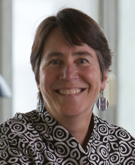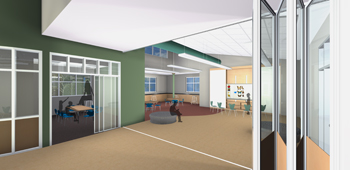Designing Schools for 21st Century Learning
School design is crucial in order to accommodate the changing needs of students, staff and teachers. Architects have been working side-by-side with school officials to deliver spaces that provide the best opportunities for student learning. With new technologies and innovative teaching methods, classroom spaces have become more than just desk-filled rooms. These new classroom designs feature flexible learning spaces that have the ability to take student learning to the next level. I sat down with two well-known and experienced architects to get their thoughts on designing schools for 21st century learning and saw a trend that will hopefully only increase as more schools launch new construction and renovation projects.
 Mark Quattrocchi, AIA, principal, Quattrocchi Kwok Architects
Mark Quattrocchi, AIA, principal, Quattrocchi Kwok Architects
Since establishing Quattrocchi Kwok Architects in 1986, Mark Quattrocchi has designed numerous public and private projects. Highly knowledgeable in client responsive design, Quattrocchi has lectured at conferences and workshops, including the Coalition for Adequate School Housing, the California Association of Independent Schools, and a symposium on 21st century schools for the San Diego Unified School District.
Laura Wernick, AIA, REFP, LEED AP, senior principal, HMFH Architects Inc.
Laura Wernick is a senior principal with HMFH Architects Inc., a Cambridge, Mass., architecture firm focused on the academic market. A registered architect and Recognized Educational Facilities Planner, she is extremely active in the national dialogue on architecture and education.
 Q: What does it mean to design schools for 21st century learning?
Q: What does it mean to design schools for 21st century learning?
Quattrocchi: To answer that question, first you have to look back to what has been done before. If we look back at the late 19th to the 20th century, school designs were really more around a factory model. Students would start first grade on one side of the school and march their way through a series of boxes, sometimes referred to as cells and bells. A teacher gives the student the information, the student tests on it and moves on to the next grade. That may have worked well with some of the skills we expected from the workforce going off to college in parts of the 20th century, but if you look at 21st century skills and as an employer myself, the skills are very different now. Suddenly we look for teamwork, collaboration, critical thinking skills and problem solving. We look for different things in the workforce now, so we begin to question, ‘Should we look at the way we teach differently?’
It’s been researched and proven that standing up and lecturing on a topic to a student is the least effective way for students to learn. Everyone learns differently, so what we’ve seen is that maybe 21st century teaching should be finding a variety of ways to teach for students so they can better access information. So now, as an architect, it begins to make me ask the question, ‘Well, then do we design a classroom differently?’
If teachers are teaching differently and working with students in big groups, or if students are working in small groups, or if there’s peer-to-peer individualized learning and even technology-infused learning, that implies a very different type of space, so perhaps we need to look at a classroom in a very different fashion than we did before.
Wernick: It means that the school has been designed with an understanding of the latest neurological research on how we learn, and it means that the school has been designed to be energy efficient and sustainable. Brain research tells us that we learn best when we are actively constructing solutions to problems, particularly when there are hand/mind interactions.
We also know that different people learn in different ways, so we need a variety of spaces to support different learning styles and different size groups. These spaces should be manipulated easily, either with furniture or movable displays, providing space for both active and reflective learning and with opportunities for performance, movement, presentation, experimentation and a range of social interactions and collaborative exploration. It is also critical that the learning take place in an environment that is both interesting and a memorable place to inhabit.
 Finally, having a school where natural lighting is used generously and wisely, and where there is a high degree of thermal comfort and indoor air quality, helps create a healthy and supportive environment for learning.
Finally, having a school where natural lighting is used generously and wisely, and where there is a high degree of thermal comfort and indoor air quality, helps create a healthy and supportive environment for learning.
Q: What are some recent projects you’ve worked on and how have you designed these schools to fit the needs of 21st century learning environments?
Quattrocchi: There are a couple projects that I’ve worked on that really show how you can design a school for 21st century learning. A recent project we just completed was Ross School. One of the things we find is that when we sit down and ask teachers questions, any architect that is good at what he does, doesn’t design the last school he did and doesn’t design the school that he or she went to, but asks those teachers who are teaching and beginning to explore 21st century learning what would be different. So we grouped classrooms together, For example, when the third- and second-grade classrooms are clustered together as opposed to being in a row, there are connections between classrooms that allow teachers to begin to share. There are also common areas you can send students to and supervise them. So a group of students could be working on a project in this common area and there will be lots of eyes on what those kids are doing so they can function differently. Within the classrooms, there are greater opportunities for students to work in small groups while something else is happening in another part of the classroom.
Lastly, the use of technology, which I think is a huge part of what 21st century learning will end up being about. We’re seeing the use of interactive whiteboards — and you’ll see that at Ross School. If you really look towards the future, though, it’s really things like mobile devices, iPads and interactive television screens. In Corte Madera, Calif., we’re designing a school called the San Clemente School for the Larkspur/Corte Madera School District that will have about 450 students, but this school is uniquely different. At the Ross School they still have separate classrooms, although they are clustered around each other; at San Clemente School, when we sat down and began to talk to these teachers and the superintendent, they began to question even the notion of separate classrooms. So now what they’ll have is something we call ‘learning suites.’ This involves two teachers working together with anywhere from 40 to 50 students. So right away, it’s not a separate, self-contained classroom — we have two teachers collaborating and working with a bigger group of students, and that alone is a revolutionary shift.
For me, as an architect, it means a bigger space, but they challenged us by saying they wanted to hold a variety of activities simultaneously. They wanted the space big enough so they could gather the whole group of students, but they also wanted to be able to quickly move students if they want to break out in smaller groups or have students work on different projects. The design of the learning suites really became what the staff referred to as the ‘nooks and crannies’. The learning suites have the ability to be separated as well by a sliding glass wall, so if a large group needs to meet and make a lot of noise while a smaller group is working in the same space, you can divide the room in half to accommodate the needs of everyone.
Wernick: All of our schools are designed to meet or exceed all health and life safety codes. All of our schools are designed to exceed current energy codes. If schools are built to be energy efficient, flexible and to endure, then they will stand the test of time. Our Rashi School in Dedham, Mass., is a great example. The building is full of natural light. The plan is simple and clear and encourages informal interactions. There are a variety of both specifically programmed and more flexible spaces, allowing for a range of activities. The school is very welcoming to parents and the community. The materials are durable and easy to clean and the building is highly energy efficient. We make use of high-efficiency lighting, including LED lighting, sensors in classrooms to minimize artificial light, as well as efficient variable drive motors and low-flow fixtures, among other energy saving components. The building is designed for photovoltaic panels.
 We are just completing three new elementary schools in Concord, N.H. The classrooms are designed around an open, sky-lit Learning Commons containing a range of spaces for collaborative learning, for project-based activities, for storytelling and for media presentations. The Learning Commons are colorful, dynamic and filled with natural light. With different colored tiles creating rhythm and pattern and playing off warm wood paneling, the schools are both memorable for the children but also designed with the adult in mind. The building is infused throughout with technology. Learning will happen everywhere. Teachers will no longer be constrained by the four walls of their classrooms and parents will be encouraged to participate in activities taking place in the Learning Commons. By creating options for teaching and learning, the faculty is able to assure that every child is able to reach his or her potential.
We are just completing three new elementary schools in Concord, N.H. The classrooms are designed around an open, sky-lit Learning Commons containing a range of spaces for collaborative learning, for project-based activities, for storytelling and for media presentations. The Learning Commons are colorful, dynamic and filled with natural light. With different colored tiles creating rhythm and pattern and playing off warm wood paneling, the schools are both memorable for the children but also designed with the adult in mind. The building is infused throughout with technology. Learning will happen everywhere. Teachers will no longer be constrained by the four walls of their classrooms and parents will be encouraged to participate in activities taking place in the Learning Commons. By creating options for teaching and learning, the faculty is able to assure that every child is able to reach his or her potential.
Q: When did you first start seeing a change in design and realize that designing schools for 21st century leaning was something that really needed to be addressed?
Quattrocchi: I started seeing this as early as the mid-90s. My first real experience with this was with two high schools we were designing around the same time: one school in San Juan Batista, Calif., called Anzar High School and also Windsor High School in Windsor, Calif. Instead of having departmentalized classrooms where every subject was in a certain area and none of the classrooms really met, these schools had a different idea. The teachers started thinking maybe it would be better if we group a smaller group of students in clusters that they call a Small Learning Community (SLC) and move all those decentralized spaces into a series of these SLCs. At Anzar and Windsor High School, there are four small SLCs, and in each one they have science classrooms and then a variety of general classrooms that are used by history, language arts and math teachers. The SLCs made it so the teachers could work together, talk about the students and teach across the curriculum. It’s a much more integrated learning environment, and that was really my first experience with seeing that teachers weren’t quite working in the same way that they used to.
Wernick: School design is always evolving. Certainly in the past 10 years there have been enormous changes simply due to the growing importance of technology and the evolution of the computer from large desktop to handheld device. The ability to support technology in the classroom and to support collaborative use of technology is continuing to impact how schools are designed. A growing awareness of energy efficiency has resulted in new materials and systems that have impacted school design. For example, everything from rapidly renewable materials to daylight dimming sensors to LED lighting is now common within schools.
Equally important, the neurological knowledge of how the brain learns has grown significantly in the last decade, allowing us to better shape the environment to support the activities and experiences that most directly impact learning.
Q: In your opinion, how does design impact student learning?
Quattrocchi: One of the roles of an architect is to listen very carefully to the people we design for to see that the things they want work best for them. In order to have a design that really works, I observe the teachers in their current atmosphere and see how they teach, so I could find a way to translate the language of education into the language of building.
Some teachers that I’ve come across were working in portables, which are some of the most inflexible and unattractive spaces to work in, and these teachers were doing outstanding work in a series of portables. The lesson to me was: Architecture doesn’t make good teachers, but we can do a lot to help support teachers do good teaching. So if I spent time with them and see how they do it and understand what their needs are, maybe I can make a whole different kind of classroom than we’re all sort of used to making before.
Wernick: Research has shown that good natural light and views of the outdoors, as well as good thermal comfort, directly impact a student’s ability to learn. There is also evidence showing that students learn best through active problem solving, hands-on project-based activities and collaborative interactions with others. Schools can be designed to better support these types of learning modes.
Q: When you start a project now, what are some of the "must-haves" schools tell you they need in the design? How is this different from say, five or10 years ago?
Quattrocchi: The things that I hear the most for 21st century learning environments is having highly flexible and adaptable spaces. They want to be able to manipulate the room to accommodate a whole variety of different ways for students to work. Furniture is a big concern and it’s hard to believe that would be an issue, but while talking to teachers they say, ’I would do more of this but my tables are so hard to move and it’s such a hassle.’ Using furniture on wheels is a great way to solve this and we’ve done this in other school designs before, including American Canyon High School in American Canyon, Calif.
Teachers also want the ability to change the room and that could be by incorporating a divider in the classroom. This way, students can break out in smaller groups quickly without having to move to a different room. Teachers also wanted to break away from the ’teaching wall,’ which just means they didn’t want a designated area to teach, but instead maneuver around the classroom and teach from all angles.
Wernick: The must-haves include areas for project-based learning and either learning commons or libraries that are designed to support a range of activities including collaborative use of technology, presentation, social interactions and project areas. These are taking the place of more traditional libraries, particularly as the density of books required declines and the need for active problem solving increases.
More flexible and more soft furnishings are now being requested. Dedicated computer rooms are rarely requested as computers become smaller and access to computers is more ubiquitous.
